Owning a motorbike means you will need to perform regular safety and mechanical checks to keep it roadworthy. They will help you minimise your risk of having a breakdown and will ensure that your bike’s performance is kept as good as possible, short of having an overhaul by a mechanic or replacing parts with better ones.
These checks take just a few minutes and should be done every month or so. You’ll see potential problems before they become major problems, and you’ll be able to address them quickly which will save you money in the long run.
Basic checks
You don’t need any mechanical aptitude to perform these quick checks.
Lights
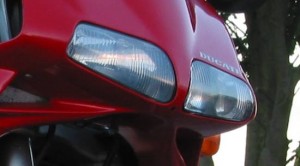 Lights help you see and be seen. You will need to check your main beam and full beam lights. If you have twin lights like the ones shown, check both sides; if you have a combined light then your full beam filament will be next to the main beam filament.
Lights help you see and be seen. You will need to check your main beam and full beam lights. If you have twin lights like the ones shown, check both sides; if you have a combined light then your full beam filament will be next to the main beam filament.
Check your indicators front and back. If your indicators aren’t working it puts you at risk because other vehicles won’t be able to tell that you are turning.
Check your rear light and brake light. If you don’t have anyone to help you with this, you will be able to see your rear light reflected in a window after dusk. It’s important your brake lights work or you run the risk of a vehicle behind you running into you. Also make sure that your brake light isn’t on all the time – this is dangerous, too.
When you’ve finished checking your lights, check your horn.
Brakes
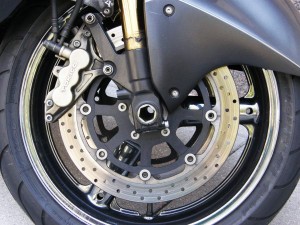 Grab your front brake and check that it stops the bike from being moved. Now do the same with the rear brake – check that it locks the wheel (you may still be able to move the bike, but the wheel will skid along the road). You should be able to apply the brake fully without reaching the full extent of travel of the brake lever (front brake) or brake pedal (rear brake).
Grab your front brake and check that it stops the bike from being moved. Now do the same with the rear brake – check that it locks the wheel (you may still be able to move the bike, but the wheel will skid along the road). You should be able to apply the brake fully without reaching the full extent of travel of the brake lever (front brake) or brake pedal (rear brake).
The brake pads should be clear of the brake discs when the brakes are released. If not, the brake is dragging on the disc and will be causing heat; you might smell them burning when you are riding. Look for instructions how to adjust the brakes on your particular bike.
Check the brake discs for any minor cracks. You will more than likely feel major cracks when you apply the brakes. If your brakes pulse when you apply them, your disc might be warped. This is often caused if you’ve overheated your brakes. The only solution is to replace the disk.
Chain
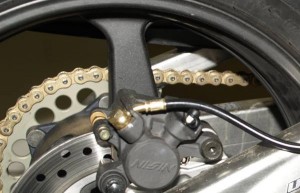 The majority of bikes are driven by a chain. This chain must be lubricated periodically so that it doesn’t wear out before its time. If your chain is dry you can use an aerosol chain lube, but it’s very important that you don’t get this on your tyres.
The majority of bikes are driven by a chain. This chain must be lubricated periodically so that it doesn’t wear out before its time. If your chain is dry you can use an aerosol chain lube, but it’s very important that you don’t get this on your tyres.
The chain also needs to be at the right tension so that it doesn’t come off the sprocket. A typical chain tension usually allows for around 30mm of deflection, but your service manual will be able to tell you the exact amount. If it’s too loose you’ll find adjusters at the end of the swing arm that will allow you to tighten up the slack. Your chain will go slack over time naturally.
Check the chain and the sprocket for any obvious signs of wear, e.g. links look worn, sprocket teeth look worn, etc.
Tyres
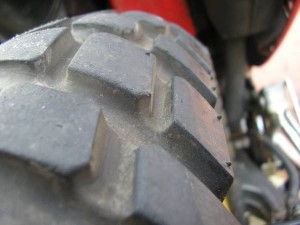 Each tyre is your fist-sized contact with the road. They have a recommended inflation level. Less than this and you’ll find that the tyre will squirm; there will be more movement in the blocks which creates unnecessary heat, and the tyre will wear quickly. If too much heat is generated it degrades the tyre and can cause delaminations.
Each tyre is your fist-sized contact with the road. They have a recommended inflation level. Less than this and you’ll find that the tyre will squirm; there will be more movement in the blocks which creates unnecessary heat, and the tyre will wear quickly. If too much heat is generated it degrades the tyre and can cause delaminations.
If the tyre is over-inflated less of it will be in contact with the road, meaning less grip. You will also feel that your ride is harder.
Check the tread and remove any stones or debris caught in it. Check for cuts or bulges – either of these means you should replace the tyre as it will be at risk of blowout which can have fairly serious consequences on a motorbike if you are cornering at the time.
Check that your tread depth meets the minimum amount required. Any tread depth less than 3mm has an exponential drop off in effectiveness in wet weather. Also, the less tread you have, the more susceptible the tyre is to getting a puncture.
Fluids
Your bike should be level before you try to check fluids otherwise you might get a false reading.
Brake fluid should be topped up to the maximum line. Check the reservoir cap or the service manual for the type of fluid you need.
Coolant won’t usually be low unless you’ve got a leak. It should be between the minimum and maximum line. Check your manual or online to find out what coolant is recommended.
Many bikes have an inspection window to let you check the oil level. If it doesn’t have one, use the dipstick: take it out, wipe it, put it back in, take it out, take the reading, then put it back in. Your engine needs to be cold to give you an accurate reading. Don’t overfill it.
Servicing
You can do servicing yourself if you have some tools and an area to do it. There are many books on servicing specific bikes, and if you look on YouTube you’ll find people who have created quick video guides for just about anything to do with servicing a motorbike. Service intervals will be either based on number of kilometres covered, or time since the last service.
Spark plugs
Corrosion of the plugs happens over time and this reduces your power. If you have a feeler gauge, check the spark plug gaps and adjust them back to the proper gap.
Air filter
If you have a paper filter you can simply tap it to dislodge dust; if you have a foam one these usually need to be washed in solvent and dried properly.
Oil and oil filter change
You’ll need something to catch the old oil in, and a place to dispose of it safely and legally. Put a tray underneath the sump and remove the drain plug. The oil will drain into the tray. Unscrew the old filter and screw in a new filter of the same kind. Screw the drain plug back in carefully so that you don’t cross-thread it.
Brake pads
Over time your brake pads will wear out. As the pads get thinner they overheat more quickly. You can prolong the life of your pads by using your brakes less – better anticipation and acceleration sense. If you want to change your brake pads yourself you’ll find plenty of videos on YouTube explaining how it’s done, like this one.
Clutch
If your clutch is slipping it will need changing as it is almost worn out – this is a job for professionals. If you find that you can’t make smooth gear changes, but the clutch isn’t slipping, it might be that your clutch cable has stretched and simply needs adjusting on your handlebars.
Lubrication
You will have some items on the outside of your bike that need lubrication periodically, including clutch lever, gear change lever, cables, stand and brake pedal. Don’t get any lubrication on your pegs, though.
Exhaust
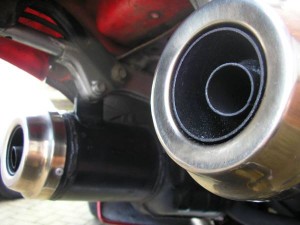 Check your exhaust doesn’t have any holes or cracks in it and doesn’t exceed the legal noise limit (you’ll need to take it to a testing station if you don’t have a decibel meter).
Check your exhaust doesn’t have any holes or cracks in it and doesn’t exceed the legal noise limit (you’ll need to take it to a testing station if you don’t have a decibel meter).
Check the mounting brackets are tight so that your exhaust isn’t flopping around or rattling.
